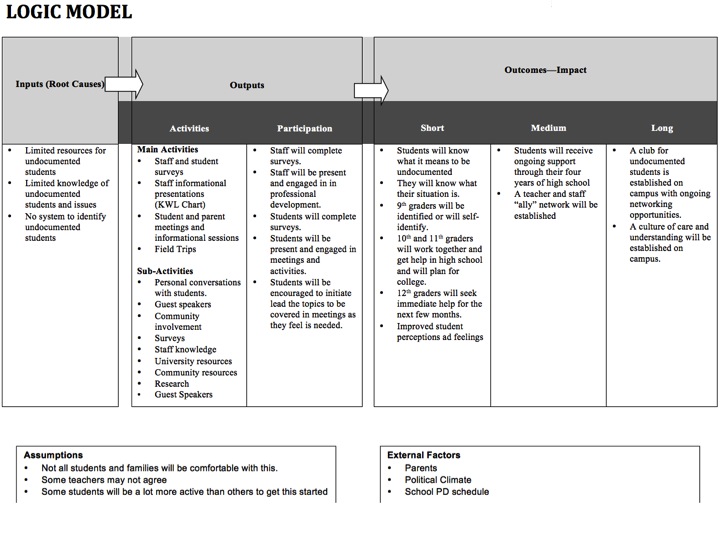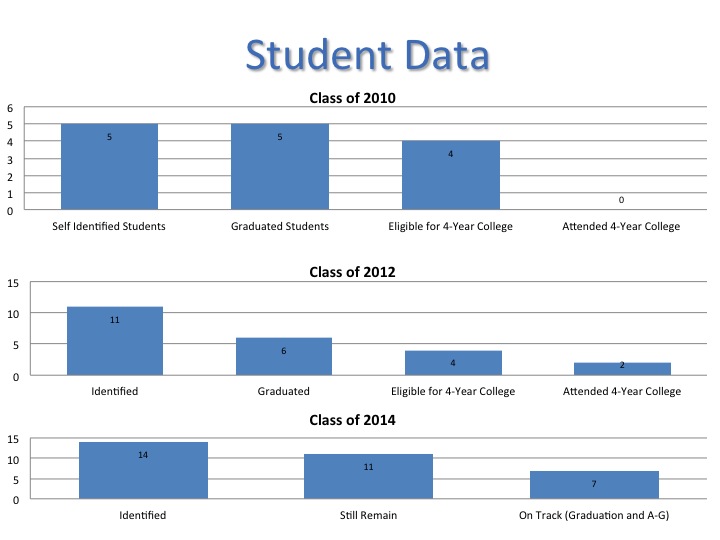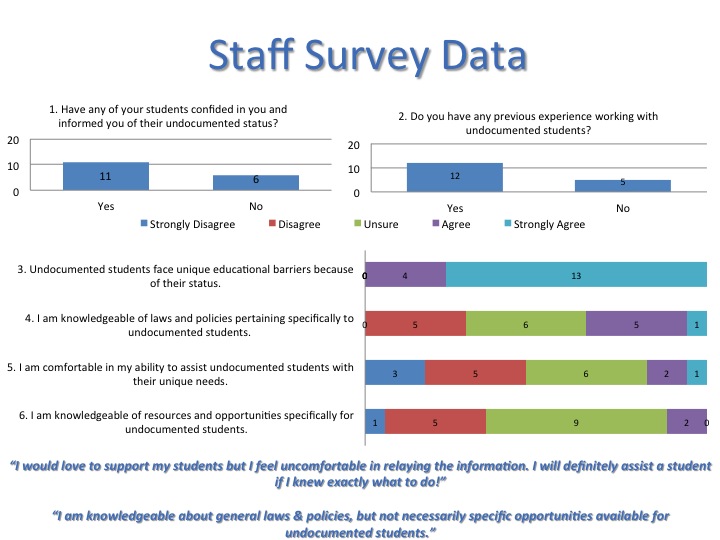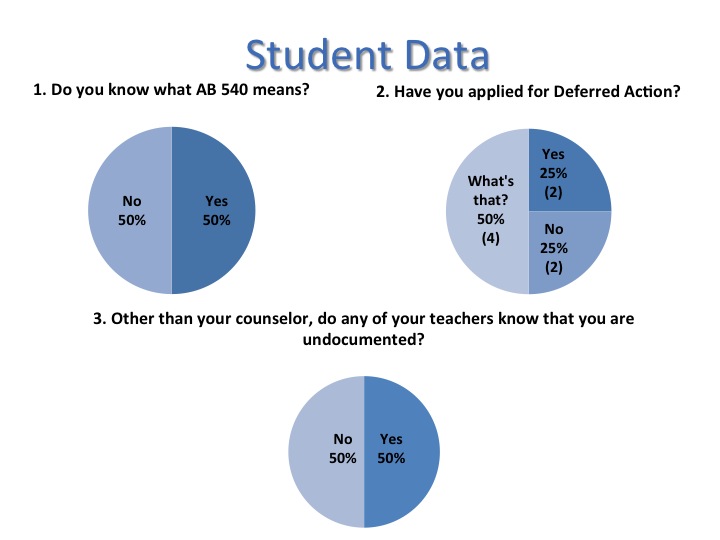PLI Leadership Project: AB 540 Club
Narrative
My goals for my PLI Leadership Project were to engage all school stakeholders to support undocumented students at my school. Though a minority group, in terms of total numbers, undocumented students have been a historically marginalized population at Ánimo Venice Charter High School.
One of the biggest challenges that I have faced as a high school counselor has been how to best support undocumented students. There are several reasons for this challenge, a few of which include: Not being able to easily identify undocumented students; not being completely updated with changing policies related to undocumented students; students’/parents’ hesitancy to discuss their undocumented status (or not even being aware of it themselves); limited resources for undocumented students; uncertain political and economic times; and limited opportunities to target these students’ unique needs without further victimizing them. Undocumented students are representative of the entire student body at my school – ranging from the highest-achieving, most cooperative and prepared for college, to the students in most need of interventions at all levels. They are spread across all grade levels of our predominately Hispanic/Latino population. The problem is that undocumented students are not able to reach their full potential as easily as other students – whether that is to attend college or get a job – because of their undocumented status. Our school’s mission is to help prepare students for college, leadership, and life. Many undocumented students, who would otherwise be considered likely to succeed, often have additional barriers because of their status.
Every year at my school I try to identify more undocumented students for my own personal records so that I can have a targeted group of students to provide supports and resources to as they become available. In order to do this, I wanted to systematize the process, instead of providing patchwork help to students as they approach me. For that reason, the goal of my charter was to create a club on campus that will provide support for undocumented high school students to help them navigate high school and the road to college and/or employment. The main purpose of the club is to better serve the needs of undocumented students by identifying them/making themselves comfortable enough to self-identify, educating them on issues relating to their status, providing them with valuable information and resources, helping them to network, and advocating for their needs. Students and staff will be able talk about the needs of undocumented students by educating students and staff members and bringing awareness to them. The primary goal is to directly help students, however, this is more easily done when the culture of the school fosters this kind of support.
The expected outcomes are that a supportive culture of care and more resources will be established on my campus for undocumented students. The long-term outcomes are that students will have access to more specific information and resources, which will help them to better access college, work, and possible paths to citizenship. The more immediate outcomes are that staff will be made more aware of the barriers that undocumented students face, the laws that relate to undocumented students, and they will be better able to provide them with support (or point them in the right direction in order to receive more support). Immediate outcomes will also be that current undocumented students will be better able to understand their situation and seek appropriate help. They will learn about opportunities specifically for them in high school and college and will begin to network with people who can help them. Four main goals exists for this club, which include: Identification, Education (of students and staff), Networking, and Advocacy.
I identified root causes by surveying undocumented students, surveying my staff, personally interviewing some of my students, and researching the barriers and supports of undocumented students, primarily from the works of Enriquez (2011), Gonzales (2010), and Perez et al. (2009). My PDSA cycles revolved around how to best engage undocumented students. While I identified about 30 students and spoke to each of them personally, when it came time to engage them in group activities, many were understandably hesitant to participate. I focused on working with those who were in order to get the group started.
My leadership role in this project began with me making the problem known to the school community. After I identified many of the students (none of which were identified by name to staff members), I gathered data on the struggles of previous undocumented students at our school. I also shared survey data from staff and student surveys and presented national statistics on undocumented students. I researched important legal issues that pertain to undocumented students and proposed my ideas for support. By highlighting the issue to the rest of the staff, especially in terms of specific data form our school, I was able to get a lot of buy-in from them. I presented similar information to specific undocumented students and asked them specifically what they are looking to get from the club. Since then, I have been working with a small group of them on next steps in forming the club.

Since I wrote the proposal, I have had to accept the fact that my original conception of the group would have to be scaled back significantly. I imagined more students being on-board from the beginning and more participation. Of the nearly 30 students I identified, I thought I would regularly be working with about 15 of them or so, however, the core group that I have been meeting with is about 6. One of the biggest challenges that I faced was time. In my original idea for this project, I thought I would have been able to meet with students more often throughout the winter and early Spring, but I was not able to for various reasons – primarily because of my commitment to coaching soccer as well the normal demands of my job and having to meet with parents of all of my students. The main change that I have made has been to accept the fact that, while I may not have a club up and running yet this year, I have started the conversation with students and have set the foundation for a club for next year. The basis for this is that I would prefer to have a group of motivated student leaders leading this club rather than me forcing it upon students, especially after reading some of the literature on student engagement and youth participation in Rogers’ ED 440 class. Although I am working with fewer students than I had anticipated, I feel as though this group is more focused than they would have been as a larger group. I have also changed how I planned to engage parents. I wanted to engage with them much more directly, however I have been having a challenging enough time engaging students. I did help to organize an event where an immigration lawyer came to school to speak to parents and I have sent out information regarding an empowerment conference for undocumented students and families, however this information was sent to the entire school. It has been difficult to make time to specifically target parents, especially since my targeted students are not participating as much as I had anticipated. My ideas for the club remain the same, however my timeline for when it will be establish and for when I might see significant improvement has changed.
I started by collecting data on my known undocumented students from previous years. This data set the foundation for all of the work to come, as it framed the problem in terms of how many undocumented students that I identified and their success in high school (See data below).

Reflections on Leadership
Throughout this process, I have reflected on many things that I would do differently. First and foremost would be to dedicate more time to it at the beginning of the year. Although part of my PLI experience has been to plan for the implementation of this, the reality is that a lot of my time was already dedicated to other activities even prior to starting this program. Over this summer, as I am looking at how to divide up my time, I am definitely going to carve out some more time to help this project improve. Additionally, I am going to enlist the help of several teachers who have expressed interest in taking a more active role with this group of students. Primarily, I want to work closely with a 10th grade social studies teacher to discuss immigration and social issues in his class in an attempt to engage more students through curriculum, as opposed to attempting to engage them out of class. I would also like to work more directly with the teacher in charge of our advisory curriculum to figure out how to introduce these ideas in advisory to the entire school without victimizing or publicly identifying undocumented students who would prefer not to be identified. In general, the feedback I received from staff was positive, as evidenced in the data below, based on the district professional development rubric. 27 staff members signed in to the PD I prsented and 17 of them fully completed an exit slip.

This project helped to improve my identity as a leader. I felt very confident in my ability to present meaningful data and relevant examples to a group of my peers in order to enact change. I feel as though I have done a much better job of getting staff buy-in than actually implementing this project so far. The course requirements helped me with this by forcing me to collect data, research, and stories, which would help my audience see the relevancy of this problem at my school. All of the tools have been helpful so far, especially the charter outline and the presentation I was forced to make in Dr. Quartz’s Ed 411 class. I slightly modified that presentation and delivered it to my staff and students. In fact, that entire class was extremely helpful as it equipped me with all of the tools needed to plan and implement my project. Throughout the year I consistently found myself referring back to my Leadership Project Proposal assignment.
The final outcome of this project is still up in the air, which I came to expect. I feel that so far I have already met the short-term goals of my original logic model. The pieces are in place to start to achieve the medium goals. Some staff members are already on board and I have been compiling different resources to provide to students. I still have a lot of work to achieve my long-term goals of establishing the club as part of our school culture.
My next step is to attend the 6th Annual Immigrant Youth Empowerment Conference (IYEC), hosted by the AB540 Project through IDEAS at UCLA.
Next, I plan to prepare to meet with more students at the start of the next school year. This year I met with a handful of them regularly as the year has been winding down and I have chosen what I present to them and have led the discussion. What I want to start with next year is simply meeting and allowing the students to determine what they would like to discuss as their needs change.
CPSEL Standards
Standards 1.1, 1.2 - The shared vision of my entire organization is to prepare students for college, leadership, and life. I helped to tailor this vision and plan activities to reach that vision specifically for undocumented students, which are a marginalized student population that has significant barriers which prevent students from meeting it.
Standards 2.1, 2.3 - This project aims to create a club which will be part of the long-term school culture. This will help provide equitable access to college and opportunities following high school for undocumented students. Additionally, it provides ongoing professional growth to teachers who may not have had the knowledge or the skills to work with undocumented students in the past.
Standards 3.1, 3.2, 3.3 - Some of the club's main goals fall within standard 3. One goal of this club is to ensure a safe school environment for all, in the case, undocumented students specifically. This club allows students to seek supports and help each other in an environment in which they feel they can safely disclose personal information. The long-term vision of the club is to create the infrastructure necessary for the club to be ongoing to support students over the years. Finally, the club itself is a support system to help students and family address some of their needs, relating to their undocumented status.
Standards 4.1, 4.2, 4.3 - I have partially met this standard by incorporating the needs of different school stakeholders. Thus far, I have specifically addressed the needs of teachers and students. Although I have also incorporated family needs through interacting with students, I plan to engage much more directly with families next year. Prior to formalizing this project, I did help to organize a parent meeting with an immigration attorney earlier in the year, however I had not yet decided on making this issue my PLI project. Part of the resources that I have compiled are from community organizations, both locally, statewide, and national, which help to provide assistance to undocumented students and their families.
Standards 5.1, 5.3, 5.4 - In organizing this group, one of the first things that I have stated to students and staff is that we must all agree to respect each other's confidentiality. I am only engaging students in group activities if they have agreed to participate. Although staff knows that I am working wot support undocumented students, I was very transparent with them from the beginning and let them know that I would not disclose which students are undocumented. One of the main reasons why this group has taken longer to get started than I anticipated is because I have been limited, myself, in what I know and what I can do. I have informed myself tremendously throughout the course of this year by doing research, signing up for informational and advocacy e-mail lists, and will be attending a workshop over the summer. I have become increasingly committed to this cause and have motivated fellow staff members to do the same. I have also found myself looking at things outside of the work setting with a special lens towards the equity of undocumented students and families.
Standards 6.1, 6.2 - Although in the short time that I have been working on this, my influence has not spurred much advocacy beyond my school, I feel as though I have planted a seed. Additionally, I have reminded school staff to protect the identity of any undocumented students that self-identity, as prescribed by FERPA laws. I have engaged with stakeholders, predominately students, teachers, and administrators, at this point. One of the biggest things that this project has done for me has been to help me realize that not only am I leading my students and staff members within my school, I am also part of a larger team and movement to help address civil and human rights issues for undocumented students.
Supporting Documents
Here is a poster for an attorney who presented at our school for interested parents. I started to identify undocumented students and invited their parents to attend this presentation prior to starting any real work on my PLI Project.
I used this KWL Activity to start my presentation to see how much stakeholders know, what they want to know, and what they learned.
Here is the presentation that I gave to staff and students.
This is the district PD rubric that I used for staff to rate my professional development lesson.
These are some of the notes I have been taking as I meet with my small group of students.







